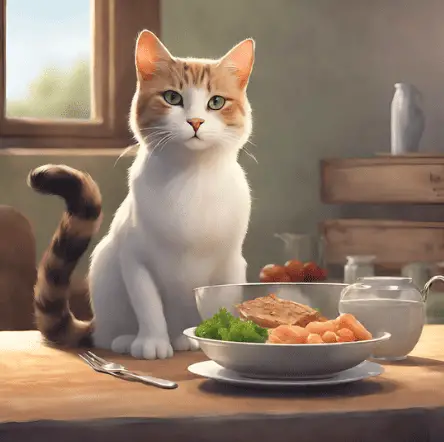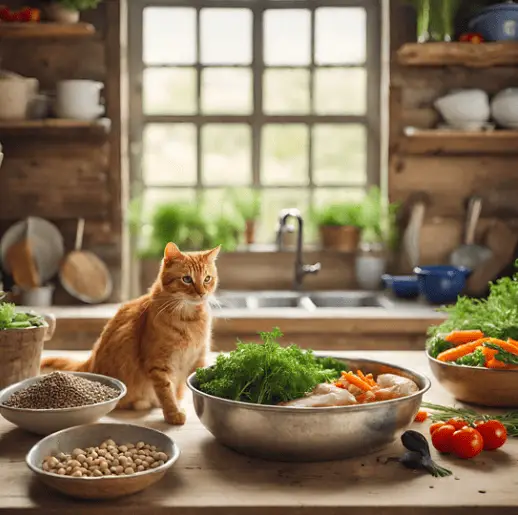
As a cat owner, I know that finding the healthiest way to feed our feline friends can be as tricky as herding cats. But fear not, because in this article, I’ll be your guide through this nutritional jungle.
Think of me as your trusty GPS, leading you to a balanced diet that will keep your cat purring with contentment. Together, we’ll explore the benefits of a balanced diet, the role of portion control, and how to choose the right cat food brand.
Let’s embark on this journey to treat our furry companions right.
KEY TAKEAWAY
What is the healthiest way to feed a cat?
The healthiest way to feed your cat involves a balanced diet of high-quality cat food, proper portion control, and access to fresh water.
Understanding the Nutritional Needs of Cats
Understanding the nutritional needs of cats is essential for providing them with a healthy diet. As a cat owner, it’s important to recognize that cats are obligate carnivores, which means they require a diet primarily consisting of animal-based protein. Unlike dogs, cats can’t meet their nutritional needs from a vegetarian or vegan diet.
Cats have specific requirements for essential nutrients such as taurine, arachidonic acid, and vitamin A. Taurine, for example, is crucial for maintaining healthy vision, heart function, and reproductive health in cats. Without adequate amounts of taurine in their diet, cats can develop serious health issues.
Protein is a vital component of a cat’s diet as it provides the necessary amino acids for growth, repair, and maintenance of body tissues. High-quality animal-based protein sources, such as poultry, fish, and meat, are recommended for cats. These sources not only provide essential amino acids but also contain essential fatty acids, vitamins, and minerals.
Carbohydrates, on the other hand, aren’t a necessary component of a cat’s diet. While some carbohydrates can be included in their diet in small amounts, cats have a limited ability to digest and metabolize them effectively.
The Benefits of a Balanced Diet for Cats
I’ve seen first-hand the benefits of feeding my cat a balanced diet. Providing a diet that meets all of a cat’s nutritional needs is essential for their overall health and well-being. Here are some of the benefits of a balanced diet for cats:
- Improved Digestion: A balanced diet provides the necessary nutrients, such as proteins, fats, and carbohydrates, in the right proportions. This promotes healthy digestion and prevents digestive issues like constipation or diarrhea.
- Healthy Weight Maintenance: Feeding a balanced diet helps cats maintain a healthy weight. Obesity in cats can lead to various health problems, such as diabetes, joint issues, and heart disease. A balanced diet ensures that cats receive the right amount of calories without excess.
- Enhanced Immune Function: A balanced diet provides essential vitamins, minerals, and antioxidants that support a cat’s immune system. A strong immune system helps cats fight off infections and diseases more effectively.
By feeding my cat a balanced diet, I’ve witnessed improvements in her overall health, including a shinier coat, increased energy levels, and a more robust immune system.
It’s crucial to consult with a veterinarian to determine the specific nutritional needs of your cat and provide them with a balanced diet tailored to their individual requirements.
The Role of Portion Control in Cat Feeding
How can I effectively implement portion control in my cat’s feeding routine, and why is it important?
Portion control is a critical aspect of maintaining a healthy diet for your feline friend. It involves carefully measuring the amount of food you provide to ensure that your cat receives the appropriate number of calories and nutrients. By implementing portion control, you can prevent overfeeding, obesity, and associated health issues in your cat.
To effectively implement portion control, start by consulting with your veterinarian to determine the appropriate daily caloric intake for your cat based on factors such as age, weight, and activity level. Once you have this information, you can use measuring cups or a kitchen scale to accurately measure out each meal. It’s important to follow the recommended portion sizes provided by your veterinarian to ensure your cat’s nutritional needs are met without excess calories.
Portion control is important because overfeeding can lead to obesity, which is a major health concern for cats. Obesity increases the risk of various health issues, including diabetes, heart disease, joint problems, and decreased lifespan. By controlling the portions and feeding your cat the right amount of food, you can help them maintain a healthy weight, improve their overall health, and increase their quality of life.
Wet Food Vs. Dry Food: Pros and Cons
When it comes to feeding my cat, I’ve to consider the pros and cons of wet food versus dry food. Both options have their advantages and disadvantages, and it’s important to make an informed decision based on what’s best for my cat’s health.
Here are the key points to consider:
- Hydration: Wet food has a high moisture content, which can help ensure that my cat stays hydrated. This is particularly beneficial for cats who may not drink enough water on their own.
- Dental Health: Dry food can help promote dental health by helping to reduce plaque and tartar buildup. The crunchy texture of dry food can help clean my cat’s teeth as they chew.
- Palatability: Wet food often has a stronger scent and flavor, which can be more appealing to picky eaters. It can also be easier for cats with dental issues or older cats who may have trouble chewing.
Ultimately, the decision between wet and dry food depends on my cat’s individual needs and preferences. It’s important to consult with my veterinarian to determine the best option for my furry friend’s overall health and well-being.
How to Choose the Right Cat Food Brand
I can find a variety of cat food brands at my local pet store, but it’s important to choose the right one for my cat’s specific dietary needs. When selecting a cat food brand, it’s crucial to consider factors such as the cat’s age, health condition, and activity level. The Association of American Feed Control Officials (AAFCO) sets nutritional guidelines for pet food, so it’s essential to choose a brand that meets these standards.
One important consideration is the ingredient list. Look for a cat food brand that lists a high-quality source of protein as the first ingredient. Cats are obligate carnivores, meaning they require a diet rich in animal protein. Avoid brands that list fillers, by-products, or artificial additives.
Another factor to consider is the type of cat food. Dry food, also known as kibble, is convenient and can help promote dental health. Wet food, on the other hand, provides hydration and may be more suitable for cats with urinary or kidney issues. Some brands also offer specialty diets, such as grain-free or hypoallergenic options, for cats with specific dietary sensitivities.
Lastly, consult your veterinarian for guidance. They can assess your cat’s unique needs and recommend a suitable cat food brand. Remember, choosing the right cat food brand is vital in ensuring your furry friend receives all the necessary nutrients for a healthy and happy life.
Healthy Cat Treats: Finding the Perfect Snacks
As a cat owner, I always try to find the healthiest treats for my feline friend, so now it’s time to explore the perfect snacks. When it comes to choosing healthy cat treats, there are a few key factors to consider. Here are some guidelines to help you find the best options for your furry companion:
- High-quality Protein: Look for treats that are made with real meat or fish as the main ingredient. Cats are obligate carnivores, meaning they require a diet high in animal protein to thrive. Treats with a high protein content will help support your cat’s overall health and provide them with essential amino acids.
- Limited Carbohydrates: Cats have a limited ability to digest carbohydrates, so it’s important to choose treats that are low in carbs. Avoid treats that contain fillers such as corn, wheat, or soy, as these ingredients can lead to weight gain and digestive issues in cats.
- Natural and Nutritious Ingredients: Opt for treats that are made with natural and wholesome ingredients. Avoid treats that contain artificial preservatives, flavors, or colors. Instead, look for treats that are rich in vitamins, minerals, and antioxidants to support your cat’s immune system.
By following these guidelines and choosing treats that are high in protein, low in carbohydrates, and made with natural ingredients, you can ensure that your cat is getting the healthiest snacks possible.
Remember to always feed treats in moderation and consult with your veterinarian if you have any concerns about your cat’s diet.
Tips for Feeding Multiple Cats in a Household
Feeding multiple cats in a household can be challenging, but with some helpful tips, it can be a smooth and harmonious process. When it comes to feeding multiple cats, it’s important to establish a routine and provide each cat with its own feeding space. This helps to prevent competition and reduce stress during meal times. It’s also crucial to provide an appropriate number of feeding stations to ensure that each cat has access to food without feeling threatened by others.
In a multi-cat household, it’s common for cats to have different dietary needs and preferences. It’s important to take these individual needs into consideration and provide each cat with a balanced and nutritionally complete diet. This may require feeding different types of food or using separate feeding stations for each cat. Additionally, it’s important to monitor each cat’s eating habits and body condition to ensure that they’re maintaining a healthy weight.
Another tip for feeding multiple cats is to provide ample fresh water sources throughout the house. Cats have a natural preference for drinking from running water sources, so providing a cat water fountain or multiple water dishes can help encourage them to stay hydrated.
Conclusion
In conclusion, providing a balanced and nutritious diet is essential for maintaining the health and well-being of cats.
One interesting statistic is that approximately 60% of cats in the United States are overweight or obese, which can lead to various health issues.
By understanding their nutritional needs, practicing portion control, and choosing the right cat food brand, we can ensure that our feline friends lead a healthy and happy life.

Stephanie Ansel is a well-known writer and journalist known for her unique and captivating writing style. She has written many articles and books on important topics such as the lifestyle, environment, hobbies, and technology and has been published in some of the biggest newspapers and magazines. Stephanie is also a friendly and approachable person who loves to talk to people and learn about their stories. Her writing is easy to read and understand, filled with lots of details and information, and is perfect for both kids and adults who want to learn about important topics in an interesting way.





